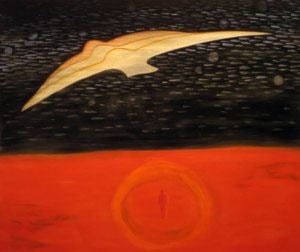Long ago, there was an annual beak competition among ravens.
Each contestant would spend hours and hours polishing their beak for the contest.
When they lined up side-by-side to be judged, they felt how absurd they all looked and told themselves: “We do not need to participate in this silly competition.
“We all have perfectly good beaks and should be proud of ourselves the way we are.”
Ever since, the beak contest was abolished forever.
Thus begins one of the modern legends written by local artist Alice Park-Spurr.
Her two-part exhibition of words and paintings, Raven Tales, is one of a trio of shows on display in the Yukon Arts Centre Gallery until mid-December.
There are many legends and stories about the magical mythical bird, but Park-Spurr decided to make up her own.
“I wanted to represent the raven the way I see them and the way I experience them — all these stories are neither true nor legends, they are my point of view,” she says.
“Somebody already wrote the other stories; I wanted to do something new, something completely for my own.”
Her tales are funny and light, but peer into an underlying moral.
Although her stories seem plucked from the annals of many religions — one involves birds in conversation with the Buddha, another aspiring to sainthood — Park-Spurr takes her spiritual cue from Zen Buddhism.
Her painting and writing are forms of meditation and relaxation.
Park-Spurr lives off the grid near Tagish Lake in a cabin she and her husband built with their own hands.
It’s 25 kilometres from the road, accessible by boat in the summer and snowmobile in the winter.
“Out there, we don’t see cars or other people; all we see is the wildlife,” she explains.
So, over decades of living in the Yukon wilds, Park-Spurr developed a close relationship with one of its most ubiquitous inhabitants — the raven.
She has become familiar with his many forms.
Raven is an entertainer with a beautiful singing voice.
He is a trickster and an imitator.
And he’s an angel and a saint.
She watches and listens and learns from the birds.
To bring them closer to the cabin, she’s crafted a unique type of backwoods bird feeder.
“We have a big stump, and all the scraps of food like chicken fat or egg yolks or beef fat we put on the stump and the grey jays and the gulls and the ravens all come.
“All kinds of birds come and the ravens jump up and down — they’re very curious and they’re very patient too.”
When they come to get food from the stump, Park-Spurr perches nearby to study the birds’ bodies and mannerisms through binoculars.
And she listens to the sounds they make as they feed and dance and circle above.
“They make so many different sounds,” she says.
They make a noise that sounds like water dropping into the sea.
They make a knocking sound.
Sometimes they sound like children.
Park-Spurr was fascinated; she couldn’t stop watching the birds and she couldn’t get them out of her head.
So she turned the obsession to her advantage and used her field notes to create her first themed body of work on the raven as a two-year labour of love.
She wrote lists of words describing the ravens’ personalities, physical characteristics and iconic connotations and pinned them to the walls of her studio.
Then used them as starting points for her paintings, which she worked on many at the same time.
She used the resulting images to craft the tales.
Park-Spurr’s ravens are not black. In fact, their feathers run the rainbow. They wear every colour but black.
If you look carefully, a raven’s feathers are not black either, says Park-Spurr.
“So many people think they’re black, but they have so many different colours.”
Depending on how the light catches them, they can be silvery, blue, green or purple.
“Painters look at colours and catch lots of things that other people take for granted,” she says.
“When I paint, it’s entirely different than when I try to use words.”
She’s not much for talking about her art.
But she doesn’t have to be. The paintings speak for themselves, says gallery curator Scott Marsden.
Korean-born Park-Spurr emigrated here from California in the 1980s.
She began painting in her secluded studio in 1989.
Raven Tales hangs in the gallery until December 23 along with John Greyson’s show Yukon Figs and Brian Kipping’s Sui Generis.
The free public gallery is open from 12 noon to 6 p.m. Tuesday to Friday and 12 noon to 5 p.m. on weekends.
